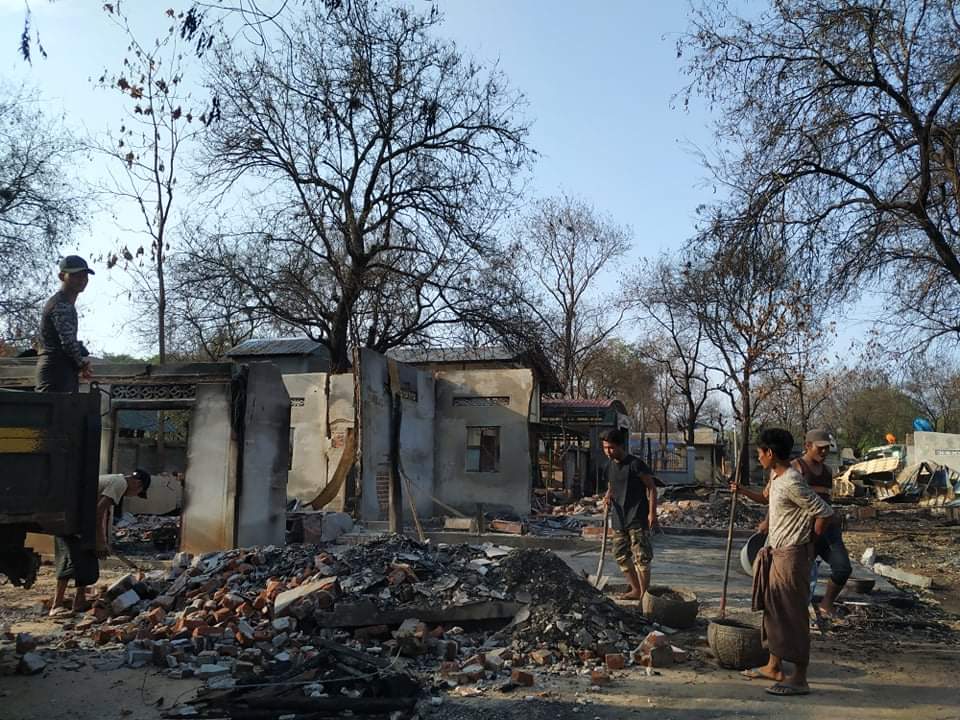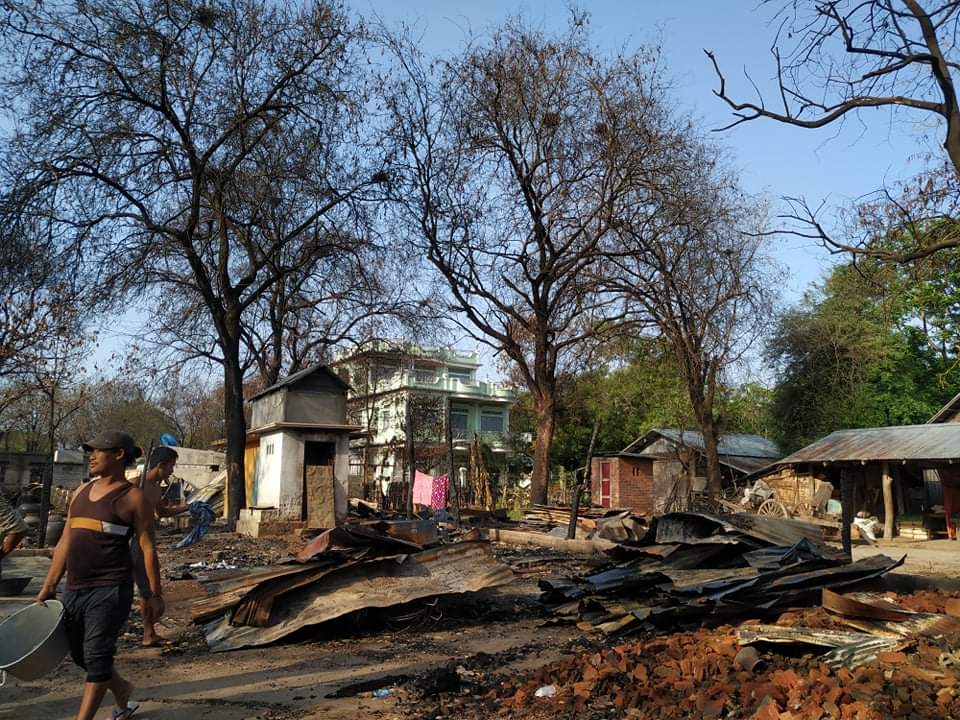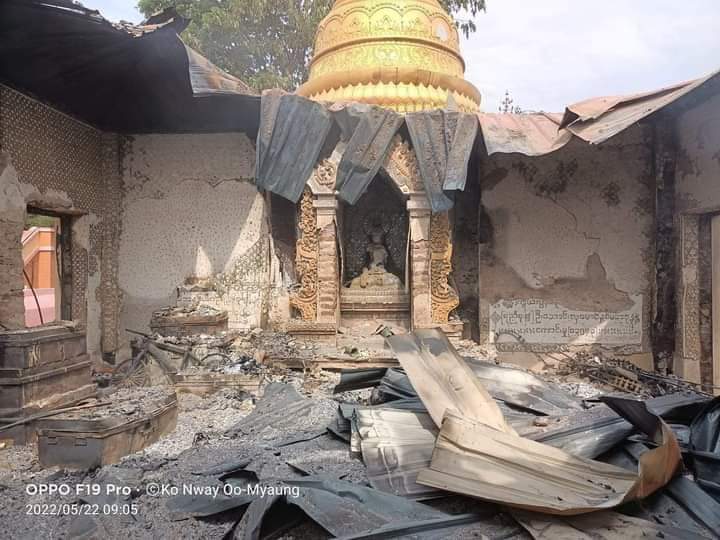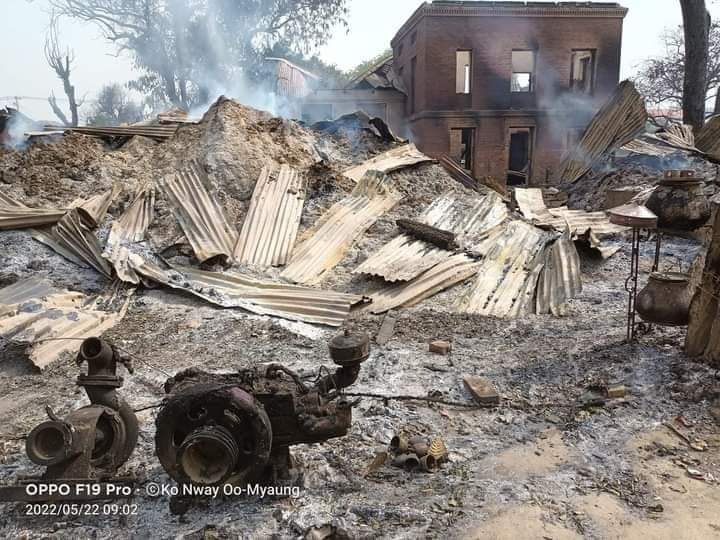This is the most stressful and difficult time for Daw Mya Mya Win, who have been hiding in the forest for three weeks since Myanmar regime soldiers torched her home during a raid on her village in late May.
The 49-year-old is a resident of Lat Chaik Village in Sagaing Region’s Mingin Township, a stronghold of the anti-coup armed resistance movement. Daw Mya Mya Win is one of many Sagaing villagers to lose everything after a junta raid.
“No place to live right now and we are short of food. And I am not in good health,” said Daw Mya Mya Win, who suffers from kidney disease.
On May 21, regime forces raided her village on the banks of the Chindwin River, firing heavy weapons as they advanced. Daw Mya Mya Win was forced to flee her home along with her family.

Soldiers traveling by motorboats from Hkamti Township destroyed the villages along the river. In the space of a month, they torched over 600 houses in 10 villages in Mingin Township. In Daw Mya Mya Win’s village of Lat Chaik, 61 out of 285 houses were burned down, including hers.
Daw Mya Mya Win recalled how she, her husband and three sons had financed the building of their home by performing general labor in the village, as their family doesn’t own farmland like some others. They started to build their two-storey house three years ago in typical upper Myanmar style: using brick for the ground floor and wood for upstairs.
There was just a little more work to be completed on the ground floor, before the Myanmar military soldiers reduced everything to ashes on May 21.
“There is nothing now. We have nothing left except two boxes of clothes. We have to rely on donors for our daily meal,” Daw Mya Mya Win said.
Junta razes the villages
Today in upper Myanmar there are tens of thousands of internally displaced persons (IDP) like Daw Mya Mya Win and her family who have lost everything: homes, vehicles, crops, animals and livelihoods.
Over a year on from the February 2021 coup, an armed resistance movement has sprung up across the country. But it is in Sagaing and Magwe regions and Chin, Kayah and Karen states that anti-junta resistance is most fierce.
In an attempt to wipe out local support for the resistance groups, regime forces are operating a scorched earth policy of torching villages.
On June 3, Data for Myanmar, an independent group monitoring junta atrocities, reported that an estimated 18,886 houses and buildings have been burned down in regime arson attacks since the coup and up to the end of May. Sagaing has suffered the most, losing an estimated 13,840 houses.
Since late April, junta forces have been targeting Sagaing and Magwe regions in a massive offensive.
In May alone, over 6,000 houses in Sagaing were torched, including Ko Zin Moe’s house in Min Tan Village in Myaung Township.

His ancestors had lived in the hardwood house, which was destroyed on the night of May 21. Ko Zin Moe, his parents, relatives and other villagers watched with eyes full of tears as the flames swallowed up their home.
“My mum and my aunts cried as they can’t replace the photos of their grandparents or the furniture which was passed down to them,” said Ko Zin Moe.
Some 158 houses out of 500 in Min Tan Village were burned down, causing nearly 2 billion kyats (US$1 million) in losses, according to the Civilians Defense and Security Organization (Myaung). The village pagoda and other religious buildings were among those torched.
“I was very angry and could not express my feelings at that time,” recalled Ko Zin Moe. His mother said it will be impossible to rebuild another similar house for the family.
Currently, thousands of locals are still hiding in the forest but some have returned to their villages and are living in temporary shelters roofed with palm leaves.
Lun Eain Thit, a poet from Lat Yet Ma Village in Magwe Region’s Myaing Township, built a shelter out of palms for his family after his two-storey house was torched by the regime on May 14.
After Sagaing, Magwe is the region most affected by the junta’s arson attacks. Data for Myanmar reported that 3,055 houses and buildings in Magwe have been burned down by the regime since the coup.
Lat Yet Ma is a large village with nearly 2,500 houses and is a commercial center in Myaing Township, with 15 other nearby villages relying on it. Located in the northern part of Myaing, it borders Kani and Pale townships in Sagaing, both strongholds of the resistance movement. Lat Yet Ma, too, has become famous for its strong anti-coup movement.
It was for that reason that regime troops raided the village on May 14 and spent two days torching it. 615 homes were burned down, causing losses of nearly 10 billion kyats (US$5.4 million), according to residents.
“The only thing left unburned was a refrigerator but it was useless as it was shot full of bullet holes,” said Lun Eain Thit of his home.
Junta troops chose to torch only well-built houses, as well as grocery stores and rice warehouses. The village hospital and religious buildings were also destroyed.
Moreover, five Lat Yet Ma villagers were killed during the raid.
NUG tries to protect the people
U Yee Mon, the National Unity Government’s (NUG) defense minister, said the military regime burns down villages in order to dismantle the revolution and divide the public from the revolutionary forces. He admitted that the villages have not been adequately protected by the NUG’s defense ministry.

“Now we are reviewing it. Especially, we are discussing with those in the No 1 Command [which includes Sagaing and Magwe regions]. We are trying our best to find the best way to protect our people,” said U Yee Mon.
Ethnic people in Chin, Kachin, Karen and Kayah states have been experiencing the junta’s atrocities for decades. And from 2017-2018, over 700,000 Rohingya fled to Bangladesh because of the Myanmar military’s clearance operations in Rakhine State. Those Rohingya refugees recalled extrajudicial killings, arbitrary arrests and arson attacks on their properties.
Currently, there are over one million IDPs in Myanmar, while 14.4 million people, around a quarter of the country’s population, urgently require humanitarian assistance, said Noeleen Heyzer, the United Nations (UN) Special Envoy for Myanmar, during her briefing on the Myanmar crisis at the UN general assembly on Monday.
“Civilian buildings and villages have been destroyed by fire and internally displaced populations have been attacked,” she said.
The junta is using violence against the people to maintain their power, said a spokesperson for the Taung Dwin People’s Defense Force (PDF) in Sagaing’s Mingin Township.
“We PDFs are designated as terrorist groups by the military. In fact, they are the terrorists. They are using violence against the people” he said.
Torching houses can’t stop the revolution
Right now, the villagers who have lost their homes are angry at the regime and are preparing to intensify the revolution.
“We hate military dogs. We had to struggle very much to build our houses,’ said a villager from Magwe’s Gangaw Township.

Poet Lun Eain Thit, who is also a member of a PDF, said the regime is under pressure as they are taking many casualties.
“Therefore, they burned down civilian houses. But the more they pressure the people, the stronger the revolution will be,” he added.
Local support for PDFs will never stop, despite the regime torching villagers’ houses, said Ko Zin Moe.
He is currently volunteering as a teacher at a community school in Myaung Township under NUG administration. His mother and his relatives also provide as much food as they can for resistance groups.
Ko Zin Moe said they can endure the current situation and will continue to support the revolution until the end.
“I always remember the words my mother says when she encourages other people. She said that regime troops can destroy our property and burn down our houses. However, they can never burn down our spirit [to end military dictatorship].”
You may also like these stories:
Junta Chief to Preside Over Myanmar’s First Grand Military Review in Seven Years
Resistance Fighters and KIA Clash With Junta Forces in Northern Myanmar
Myanmar Junta Raises SIM and Internet Taxes to Silence Opposition

















